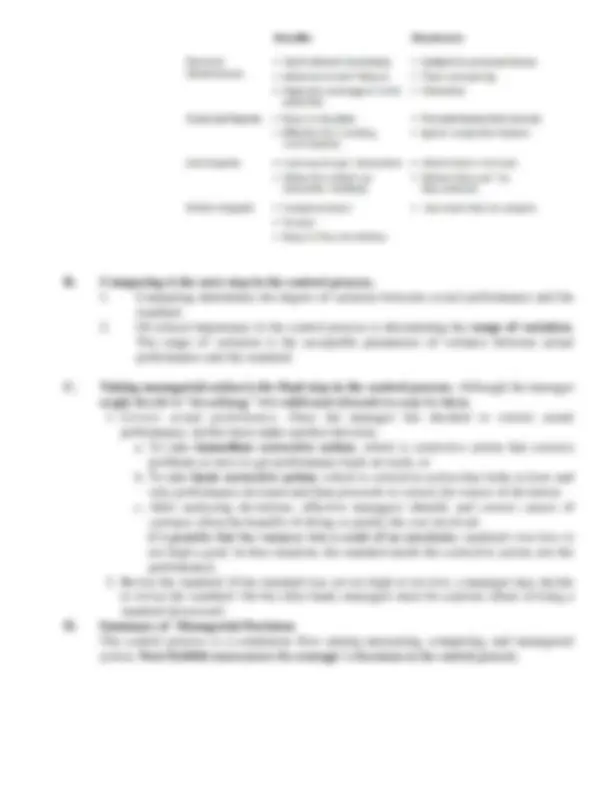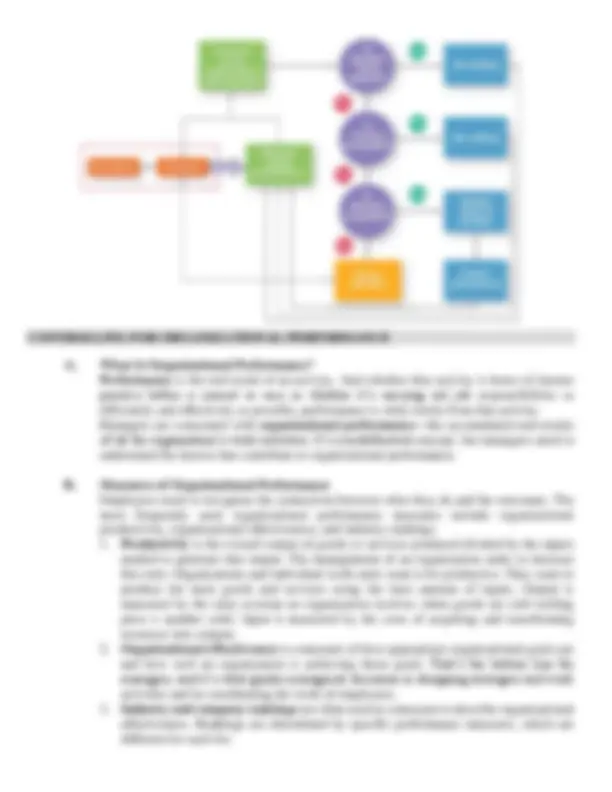




Study with the several resources on Docsity

Earn points by helping other students or get them with a premium plan


Prepare for your exams
Study with the several resources on Docsity

Earn points to download
Earn points by helping other students or get them with a premium plan
Community
Ask the community for help and clear up your study doubts
Discover the best universities in your country according to Docsity users
Free resources
Download our free guides on studying techniques, anxiety management strategies, and thesis advice from Docsity tutors
The concept of controlling in organizations, its importance, and the three-step process involved. Controlling is the final link in the functional chain of management, ensuring goals are met and providing critical feedback for effective delegation and asset protection. The control process includes measuring actual performance, comparing it to standards, and taking managerial action to correct deviations or revise standards.
Typology: Summaries
1 / 4

This page cannot be seen from the preview
Don't miss anything!



➢ Control is the process of monitoring, comparing, and correcting work performance. All managers should control even if their units are performing as planned because they can’t really know that unless they’ve evaluated what activities have been done and compared actual performance against the desired standard. ➢ The Purpose of Control Effective controls ensure that activities are completed in ways that lead to the attainment of goals. Whether controls are effective, then, is determined by how well they help employees and managers achieve their goals. ➢ Why is control so important? Control is important for three main reasons: A. Control serves as the final link in the functional chain of management. Planning can be done, an organizational structure created to facilitate efficient achievement of goals, and employees motivated through effective leadership. But there’s no assurance that activities are going as planned and that the goals employees and managers are working toward are, in fact, being attained. Controlling provides a critical link back to planning. If managers didn’t control, they’d have no way of knowing whether their goals and plans were being achieved and what future actions to take. The Exhibit show the planning-controlling link. B. Controlling is also important to delegation. The development of an effective control system may decrease resistance to delegation. Control is important, therefore, because it’s the only way that managers know whether organizational goals are being met and if not, the reasons why. The value of the control function can be seen in three specific areas: planning, empowering employees, and protecting the workplace. Many managers are reluctant to empower their employees because they fear something will go wrong for which they would be held responsible. But an effective control system can provide information and feedback on employee performance and minimize the chance of potential problems.
C. Finally, control serves to protect the company and its assets. Today’s environment brings heightened threats from natural disasters, financial scandals, workplace violence, global supply chain disruptions, security breaches, and even possible terrorist attacks. Managers must protect organizational assets in the event that any of these things should happen. THE CONTROL PROCESS The control process is a three-step process including measuring actual performance, comparing actual performance against a standard, and taking managerial action to correct deviations or to address inadequate standards. The control process assumes that performance standards already exist, and they do. They’re the specific goals created during the planning process. (See Exhibit ) A. Measuring is the first step in the control process. To determine what actual performance is, a manager must first get information about it. Thus, the first step in control is measuring. 1 - What we measure is probably more critical than how we measure. Why? Because selecting the wrong criteria can create serious problems. Besides, what is measured often determines the area(s) in which employees will attempt to excel. Most work activities can be expressed in quantifiable terms. However, managers should use subjective measures when they can’t. Although such measures may have limitations, they’re better than having no standards at all and doing no controlling. 2 - How We Measure? Measurement is frequently achieved through four common sources of information: a. Personal observation b. Statistical reports c. Oral reports d. Written reports
A. What Is Organizational Performance? Performance is the end result of an activity. And whether that activity is hours of intense practice before a concert or race or whether it’s carrying out job responsibilities as efficiently and effectively as possible, performance is what results from that activity. Managers are concerned with organizational performance— the accumulated end results of all the organization’s work activities. It’s a multifaceted concept, but managers need to understand the factors that contribute to organizational performance. B. Measures of Organizational Performance Employees need to recognize the connection between what they do and the outcomes. The most frequently used organizational performance measures include organizational productivity, organizational effectiveness, and industry rankings.